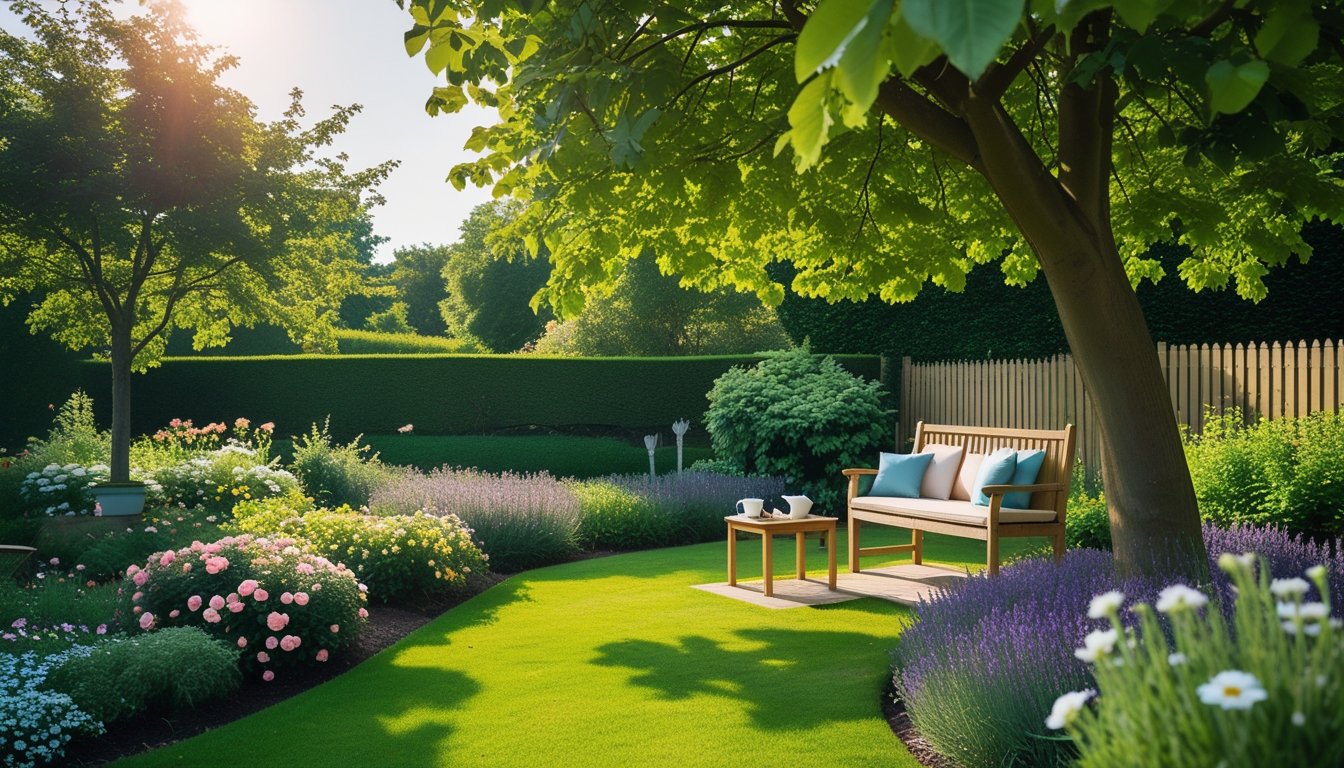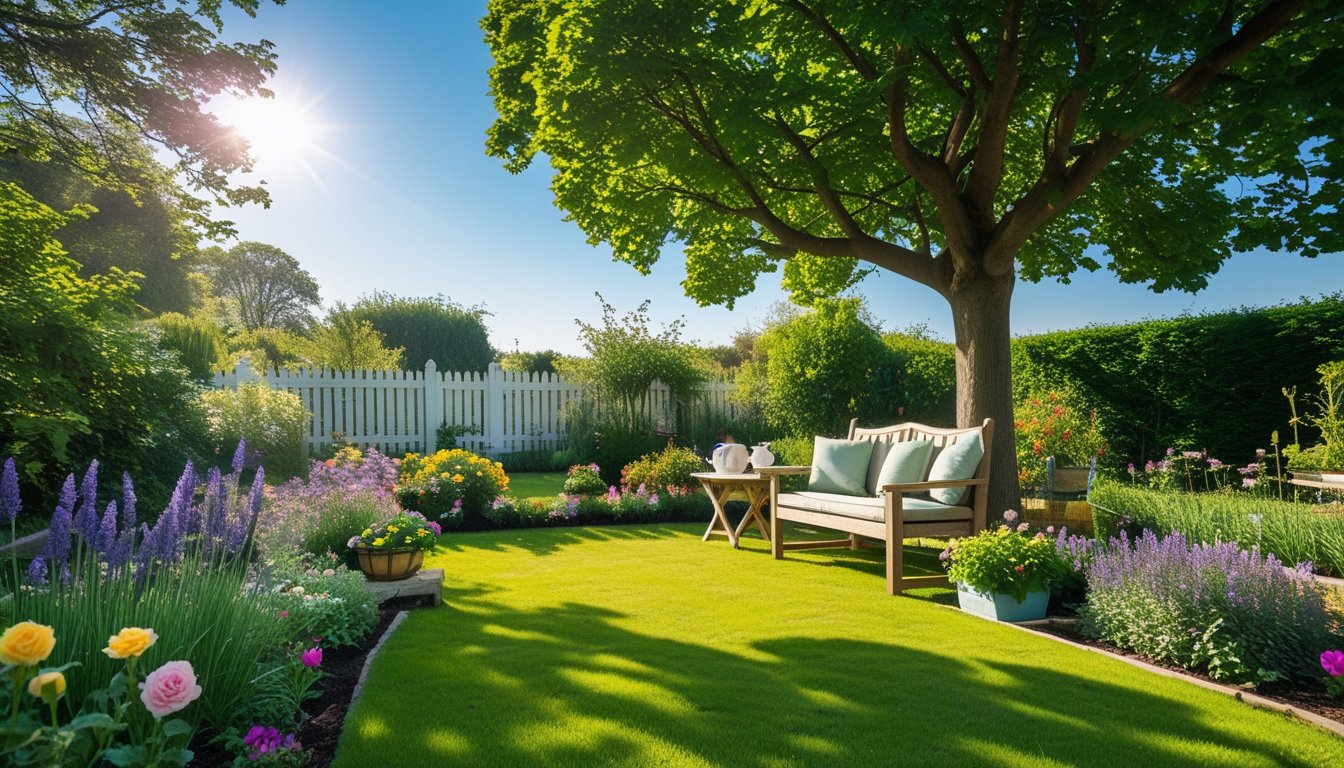Late updated: 18 Jun 2025 14:06
Written by: James Whitaker
Essential Outdoor Relaxation Tips For UK Gardens: Creating Your Perfect Retreat
Creating a relaxing outdoor space in UK gardens is essential for those who seek tranquillity in their own backyards. Gardens are more than just decorative spaces; they are havens where we can unwind and escape the hustle and bustle of everyday life. From choosing the right plants to incorporating soothing elements like water features and patio areas, we should design our gardens to encourage relaxation.

It's crucial to focus on both aesthetics and function when planning your garden. A sense of enclosure and privacy can help create an intimate environment. Meanwhile, adding features like winding pathways and inviting seating areas can enhance the ambience, making your garden the perfect retreat for any time of day.
Getting your outdoor area right means balancing design elements with personal preferences. Some may prefer the calming sounds of wind chimes, while others might lean towards zen garden influences with carefully placed rocks and minimalist plant choices. Whatever the preference, our gardens should reflect our personal need for peace.
Key Takeaways
- Focus on privacy and personal preferences
- Combine soothing elements like pathways and water features
- Balance aesthetics with relaxing features in garden design
Fundamental Principles of Outdoor Relaxation in UK Gardens

Creating a relaxing garden involves thoughtful design, careful selection of elements, and an awareness of personal preferences. By integrating tranquillity, natural materials, and soothing elements, we can transform our outdoor spaces into serene retreats.
The Importance of Tranquillity and Mindful Gardening
Gardening with a focus on tranquillity requires us to understand how spaces affect our mental well-being. Mindful gardening allows us to connect more deeply with our environment. It's about being present in the moment, whether we're planting seeds or simply enjoying the breeze.
This approach not only reduces stress but also enhances the overall harmony of our garden. By dedicating time to understand what brings us peace, we can tailor our garden to meet those needs, fostering a sense of calm and relaxation.
Creating a Peaceful Environment with Natural Materials
Utilising natural materials in our garden design can significantly contribute to a peaceful atmosphere. Stone pathways, wooden benches, and gravel areas bring an earthy quality to outdoor spaces. These elements blend seamlessly with the natural surroundings, promoting relaxation.
In addition, incorporating water features such as a small pond or a gentle fountain can introduce soothing sounds and movements. These materials and features help ground the space, making it a sanctuary where we can escape and rejuvenate.
Selecting a Calming Colour Palette and Soothing Scents
The colours and scents we choose greatly influence the garden's ambience. Soft, muted tones such as greens, blues, and lavender can calm the mind. We should consider how these colours interact with the natural light that our garden receives throughout the day.
In tandem with visual elements, choosing plants like lavender, jasmine, and rosemary can enhance the garden with soothing scents. These fragrances are known for their relaxing properties and can subtly transform the sensory experience, creating a cohesive, tranquil environment that appeals to our senses of sight and smell.
Essential Design Tips and Features for Relaxing UK Outdoor Spaces

Designing a relaxing UK garden involves strategic choices that encompass comfort, privacy, calming elements, wildlife encouragement, ambient features, and sensory zones. By addressing these areas, we can craft an outdoor haven that provides peace and tranquillity.
Choosing Comfortable Seating and Outdoor Rugs
The foundation of any relaxing outdoor space begins with comfortable seating. Durable options such as garden swings, hammocks, and cushioned chairs offer versatile comfort. Paired with outdoor rugs, these elements define living areas and add warmth.
When selecting rugs, choose weather-resistant materials that can withstand the UK's damp climate. Parasol or awning provides shade and protection, enhancing comfort even during light rain. Opt for easily movable furniture to adjust seating arrangements as needed, encouraging interaction or solitude based on mood.
Enhancing Privacy with Fences, Hedges, or Trellis
Privacy is essential for tranquility. Solid fences offer clear boundaries but might feel stark. Instead, mixing hedges and trellis structures adds depth and softens edges.
Non-invasive plants like ornamental grass and climbers can grow on trellises, contributing to a living wall effect. Consider bamboo or tall shrubs for immediate coverage. Balancing height and density will ensure privacy while maintaining an airy, open atmosphere. Privacy elements not only shield us from outside views but also help muffle urban noise.
Incorporating Water Features and Calming Elements
Water features infuse gardens with a soothing atmosphere. Simple bubbling fountains or small ponds introduce a dynamic yet calming presence. Remember, water's reflective quality can also amplify a sense of space in smaller gardens.
Enhancing a meditative feel with features like stones or garden sculptures can create a space for relaxation. Introduce seating nearby to encourage moments of reflection. Wind chimes might add a gentle auditory element, contributing to a multisensory experience that aids mental well-being.
Encouraging Wildlife: Birds, Bees, and Butterflies
Creating a connection with nature supports biodiversity and mental health. By planting native flowers and herbs like rosemary, lavender, and thyme, we attract birds, bees, and butterflies.
Wildlife-friendly choices include installing bird feeders and building small shelters or bug hotels. Perennials offer consistent food sources, and they require less maintenance. Involving ourselves in wildlife encouragement not only benefits our local ecosystem but also adds lively activity and natural beauty to our spaces.
Adding Garden Lighting and Ambient Features
Garden lighting transforms outdoor spaces into inviting sanctuaries at night. Strategically placed solar or LED lights along pathways or around seating areas can craft a gentle glow without disturbing local fauna.
Additionally, soft ambient lighting—perhaps lanterns or string lights—enhances comfort and visibility. These elements extend our gardens' usability during evenings, allowing us to enjoy limitless nights under the stars, wrapped in a safe, softly illuminated environment.
Creating Sensory, Meditation, and Edible Plant Zones
To cater to diverse relaxation methods, designate specific zones. A sensory garden engages all senses with varied textures, colours, and fragrances. Incorporating meditation spaces with minimalistic design elements like stones or sand fosters focus and peace.
Meanwhile, planting an assortment of edible plants combines beauty with utility. Fruits, vegetables, and herbs provide fresh produce and encourage a deeper connection to the land. This multifaceted approach ensures our garden is not only visually appealing but also a source of nourishment and mental clarity.
Frequently Asked Questions

In our journey of creating relaxing outdoor spaces, we often encounter common queries. Here, we address some typical questions to help you achieve a soothing garden environment.
How can I make my garden more relaxing without spending money?
We believe that even simple changes can transform your garden into a peaceful retreat. Rearranging plants or creating a quiet seating area using existing furniture can help. Utilising natural elements like rocks and wood found in your garden can elevate the tranquillity without any cost.
What are some relaxing garden ideas suitable for small UK spaces?
Compact gardens can still be serene by opting for vertical gardening techniques. Hanging pots and wall-mounted planters maximise the use of space. Carefully chosen lighting, like solar fairy lights, and a few lush plants such as lavender or thyme can bring relaxation to even the smallest areas.
Which colours promote tranquility in a garden setting?
For a calming garden atmosphere, we often recommend using gentle and muted colours. Shades of blue and green work particularly well, as do soft pastels and earth tones. These colours harmonise with nature and create a soothing visual effect.
How can I create a Zen garden on a budget?
Zen gardens focus on simplicity and peace. We suggest using sand or gravel to represent water, alongside stones that symbolise mountains. Bamboo or small water features can enhance the effect. Natural materials are typically affordable and can be found in most garden stores.
What are effective ways to create a tranquil outdoor space?
Incorporating water features such as fountains or small ponds can provide soothing sounds. The use of plants like jasmine or lavender adds both beauty and fragrance. Ensuring privacy with hedges or trellises can help create an intimate and peaceful environment.
How can I incorporate Zen elements into a balcony garden?
Limited space need not restrict Zen-like tranquillity. We can use small pots of succulents and stones for a miniature Zen garden. Including a small water feature or a bamboo wind chime provides soothing sounds. This setup encourages a meditative vibe even in confined areas.
